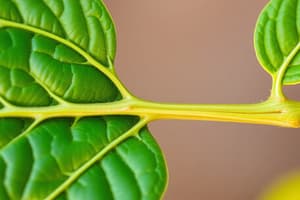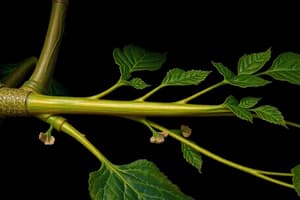Podcast
Questions and Answers
What is the primary role of the endodermis in water transport within plants?
What is the primary role of the endodermis in water transport within plants?
- It allows free flow of water into the air.
- It serves to regulate water and mineral uptake. (correct)
- It facilitates the movement of water through the stomata.
- It strengthens the plant's structure.
Which mechanism primarily drives the transpiration stream in plants?
Which mechanism primarily drives the transpiration stream in plants?
- Capillary action in the soil.
- Active transport of minerals.
- The evaporation of water from leaves. (correct)
- Root pressure from the soil.
How do stomata regulate water loss in plants?
How do stomata regulate water loss in plants?
- By opening to allow water to enter the roots.
- By controlling airflow to the vascular system.
- By closing to minimize water vapor escape. (correct)
- By facilitating the transport of water to leaves.
What is the significance of the Casparian strip in the endodermis?
What is the significance of the Casparian strip in the endodermis?
Which environmental factor is likely to have the greatest effect on transpiration rates?
Which environmental factor is likely to have the greatest effect on transpiration rates?
What is the primary function of xylem in flowering plants?
What is the primary function of xylem in flowering plants?
Which cellular components compose phloem in flowering plants?
Which cellular components compose phloem in flowering plants?
What mechanism primarily drives the movement of water in plants?
What mechanism primarily drives the movement of water in plants?
How do roots absorb ions from the soil?
How do roots absorb ions from the soil?
What role do root hairs play in water absorption?
What role do root hairs play in water absorption?
What is the pressure-flow mechanism related to in plants?
What is the pressure-flow mechanism related to in plants?
What pathway allows water to move through plant cell walls without entering the cells?
What pathway allows water to move through plant cell walls without entering the cells?
Which of the following statements about phloem is incorrect?
Which of the following statements about phloem is incorrect?
Flashcards
Symplast Pathway
Symplast Pathway
The movement of water through interconnected plant cells, passing through plasmodesmata.
Endodermis
Endodermis
A layer of cells surrounding the vascular tissue in roots, controlling water and mineral uptake.
Casparian Strip
Casparian Strip
A waterproof band in the endodermis, forcing water to enter the vascular tissue through the symplast pathway.
Stomata
Stomata
Signup and view all the flashcards
Transpiration Stream
Transpiration Stream
Signup and view all the flashcards
Xylem
Xylem
Signup and view all the flashcards
Phloem
Phloem
Signup and view all the flashcards
Vascular bundles
Vascular bundles
Signup and view all the flashcards
Transpiration pull
Transpiration pull
Signup and view all the flashcards
Nutrient absorption
Nutrient absorption
Signup and view all the flashcards
Translocation
Translocation
Signup and view all the flashcards
Root hairs
Root hairs
Signup and view all the flashcards
Apoplast pathway
Apoplast pathway
Signup and view all the flashcards
Study Notes
Transport in Plants: Overview
- Plants require a sophisticated transport system to move water, nutrients, and sugars throughout their bodies, enabling growth and survival.
- This system ensures that cells receive the necessary resources for metabolism and that products of metabolism are distributed efficiently.
- The transport network varies based on plant size and complexity, with simple systems in small plants and intricate systems in large trees.
The Transportation Structure of Flowering Plants
- Flowering plants, also known as angiosperms, possess specialized vascular tissues for transport.
- Xylem: Transports water and dissolved minerals from the roots to the rest of the plant. It's composed of tracheids and vessel elements, both dead cells that form continuous tubes for efficient flow.
- Phloem: Transports sugars (primarily sucrose) from sites of production (photosynthesis) to other parts of the plant. It's composed of sieve tube elements and companion cells, which are living cells that support and control phloem activity.
- Vascular bundles: Clusters of xylem and phloem tissues located throughout the stem and leaves, coordinating the movement of substances throughout the plant body.
Movement of Substances in Plants
- Water movement: Driven primarily by transpiration pull, a process where water evaporates from leaves, creating a tension that pulls water up from the roots through the xylem. Cohesion and adhesion of water molecules facilitate this upward movement.
- Nutrient absorption: Roots absorb ions from the soil via active transport, moving against concentration gradients.
- Translocation (sugar movement): Phloem transports sugars from sources (e.g., leaves) to sinks (e.g., roots, growing buds) via a pressure-flow mechanism, involving hydrostatic pressure differences between source and sink.
- Hormone movement: Plant hormones (e.g., auxins, cytokinins) are transported throughout the plant body, regulating growth and developmental processes. Often transported in the phloem.
Movement of Water Through a Plant
- Root hairs: Tiny projections on root epidermal cells that greatly increase surface area for efficient water absorption from the soil.
- Apoplast pathway: Water moves through cell walls and intercellular spaces without entering cells, a relatively quick route.
- Symplast pathway: Water moves through the cytoplasm of interconnected cells via plasmodesmata, regulating movement and allowing selectivity.
- Endodermis: A layer of cells surrounding the vascular tissues in the root, it controls water and mineral uptake. The Casparian strip in the endodermis forces water to enter vascular tissue via the symplast path, enabling selective transport.
- Stomata: Pores on leaf surfaces that regulate transpiration, allowing water vapor to escape and enabling gas exchange. Opening and closing of stomata is a significant factor regulating water loss.
- Transpiration stream: The continuous movement of water through the plant from roots to shoots driven by the evaporation of water from leaves and the cohesion-tension mechanism.
- Factors Affecting Water Movement: Environmental factors (e.g., light, temperature, humidity) impact transpiration rates and, consequently, water movement in the plant.
- Importance of Water Transport: Maintaining turgor pressure, nutrient uptake, photosynthesis, and overall plant function relies on efficient water transport.
Studying That Suits You
Use AI to generate personalized quizzes and flashcards to suit your learning preferences.




